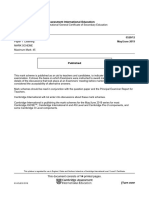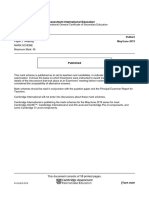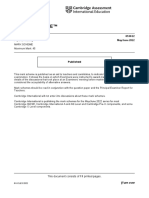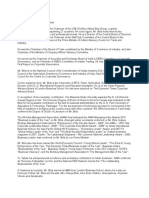Cambridge Assessment International Education: French 0520/11 October/November 2019
Cambridge Assessment International Education: French 0520/11 October/November 2019
Uploaded by
andy-cai2005Copyright:
Available Formats
Cambridge Assessment International Education: French 0520/11 October/November 2019
Cambridge Assessment International Education: French 0520/11 October/November 2019
Uploaded by
andy-cai2005Original Title
Copyright
Available Formats
Share this document
Did you find this document useful?
Is this content inappropriate?
Copyright:
Available Formats
Cambridge Assessment International Education: French 0520/11 October/November 2019
Cambridge Assessment International Education: French 0520/11 October/November 2019
Uploaded by
andy-cai2005Copyright:
Available Formats
Cambridge Assessment International Education
Cambridge International General Certificate of Secondary Education
FRENCH 0520/11
Paper 1 Listening October/November 2019
MARK SCHEME
Maximum Mark: 45
Published
This mark scheme is published as an aid to teachers and candidates, to indicate the requirements of the
examination. It shows the basis on which Examiners were instructed to award marks. It does not indicate the
details of the discussions that took place at an Examiners’ meeting before marking began, which would have
considered the acceptability of alternative answers.
Mark schemes should be read in conjunction with the question paper and the Principal Examiner Report for
Teachers.
Cambridge International will not enter into discussions about these mark schemes.
Cambridge International is publishing the mark schemes for the October/November 2019 series for most
Cambridge IGCSE™, Cambridge International A and AS Level and Cambridge Pre-U components, and
some Cambridge O Level components.
This syllabus is regulated for use in England, Wales and Northern Ireland as a Cambridge International Level 1/Level 2 Certificate.
This document consists of 14 printed pages.
© UCLES 2019 [Turn over
0520/11 Cambridge IGCSE – Mark Scheme October/November 2019
PUBLISHED
Generic Marking Principles
These general marking principles must be applied by all examiners when marking candidate answers. They should be applied alongside the
specific content of the mark scheme or generic level descriptors for a question. Each question paper and mark scheme will also comply with these
marking principles.
GENERIC MARKING PRINCIPLE 1:
Marks must be awarded in line with:
• the specific content of the mark scheme or the generic level descriptors for the question
• the specific skills defined in the mark scheme or in the generic level descriptors for the question
• the standard of response required by a candidate as exemplified by the standardisation scripts.
GENERIC MARKING PRINCIPLE 2:
Marks awarded are always whole marks (not half marks, or other fractions).
GENERIC MARKING PRINCIPLE 3:
Marks must be awarded positively:
• marks are awarded for correct/valid answers, as defined in the mark scheme. However, credit is given for valid answers which go beyond the
scope of the syllabus and mark scheme, referring to your Team Leader as appropriate
• marks are awarded when candidates clearly demonstrate what they know and can do
• marks are not deducted for errors
• marks are not deducted for omissions
• answers should only be judged on the quality of spelling, punctuation and grammar when these features are specifically assessed by the
question as indicated by the mark scheme. The meaning, however, should be unambiguous.
GENERIC MARKING PRINCIPLE 4:
Rules must be applied consistently e.g. in situations where candidates have not followed instructions or in the application of generic level
descriptors.
GENERIC MARKING PRINCIPLE 5:
Marks should be awarded using the full range of marks defined in the mark scheme for the question (however; the use of the full mark range may
be limited according to the quality of the candidate responses seen).
GENERIC MARKING PRINCIPLE 6:
Marks awarded are based solely on the requirements as defined in the mark scheme. Marks should not be awarded with grade thresholds or
grade descriptors in mind.
© UCLES 2019 Page 2 of 14
0520/11 Cambridge IGCSE – Mark Scheme October/November 2019
PUBLISHED
1 General Marking Principles
1.1 It is not possible to list all acceptable alternatives in the Detailed Mark Scheme provided in Section 2. You will need to consider all
alternative answers and unexpected approaches in candidates’ scripts, make a decision on whether they communicate the required
elements, in consultation with your Team Leader if necessary (or with your Product Manager if you are a single Examiner), and
award marks accordingly.
The following marking principles underpin the detailed instructions provided in Section 2 of the Mark Scheme. Where a decision is taken to
deviate from these principles for a particular question, this will be specified in the Mark Scheme. Often the general principles will have
to be weighed up against each other, e.g. the answer might pass the look-alike test (1.5(c)), but if the candidate has produced an answer that
is another word in the target language they will not score (1.6).
1.2 Crossing out:
(a) If a candidate changes his/her mind over an answer and crosses out an attempt, award a mark if the final attempt is correct.
(b) If a candidate crosses out an answer to a whole question but makes no second attempt at it, mark the crossed out work.
1.3 More than the stipulated number of boxes ticked/crossed by the candidate:
(a) If more than one attempt is visible, but the candidate has clearly indicated which attempt is his/her final answer (e.g. by crossing out
other attempts or by annotating the script in some way), mark in the usual way.
(b) If two attempts are visible (e.g. 2 boxes ticked instead of the 1 box stipulated), and neither has been crossed out/discounted by the
candidate, no mark can be awarded.
(c) Where candidates must tick a number of boxes (e.g. tick the 6 true statements) and tick too many, apply the following rule: deduct the
number of ‘extra’ answers indicated by the candidate from their number of correct answers. The remaining number is the mark
awarded, e.g. the candidate is asked to tick 6 statements, but ticks 8. 5 of the ticks are correctly placed, but 2 are ‘extras’ (8 ticks
placed by candidate minus 6 ticks required by rubric = 2 ‘extras’). Therefore the candidate is awarded a mark of 3.
(d) Answers in pen do not take precedence over answers in pencil, e.g. if a candidate is asked to tick 1 box and ticks 2, one in pen and
the other in pencil, the mark cannot be awarded unless there is explicit indication from the candidate as to which is his/her final
answer.
© UCLES 2019 Page 3 of 14
0520/11 Cambridge IGCSE – Mark Scheme October/November 2019
PUBLISHED
1.4 For questions requiring more than one element for the answer, (i) and (ii), where the answers are interchangeable:
(a) Both correct answers on line 1 and line 2 blank = 2
(b) Both correct answers on line 1 and line 2 wrong = 1
(or vice-versa)
1.5 Answers requiring the use of French (rather than a non-verbal response) should be marked for communication. Tolerate inaccuracies
provided the message is clear.
(a) Spellings recognised by the Académie Française will be accepted.
(b) ‘If in doubt, sound it out’: if you read what the candidate has written, does it sound like the correct answer?
(c) Look-alike test: does what the candidate has written look like the correct answer?
(d) Accept incorrect gender or person unless Mark Scheme specifies otherwise.
(e) Accept incorrect possessive adjectives, e.g. mon, ton, son etc., unless Mark Scheme specifies otherwise.
(f) Accept incorrect tense unless Mark Scheme specifies otherwise.
(g) Tolerate incorrect auxiliary unless Mark Scheme specifies otherwise.
(h) Tolerate incorrect use of infinitive unless Mark Scheme specifies otherwise.
1.6 Unless the Mark Scheme specifies otherwise, do not accept incorrect French if the word given means something else in French.
(Incorrect French which constitutes a word in any language other than French is marked (i) on the basis of whether it is accepted or refused
in the Mark Scheme and (ii) if not mentioned in the Mark Scheme, on the basis of 1.5 above).
1.7 Where words are combined or split inappropriately do not award the mark, e.g. ‘sonpère’ and ‘lar ticle’ (inappropriate splitting or
combination is an indication that the candidate has not understood).
© UCLES 2019 Page 4 of 14
0520/11 Cambridge IGCSE – Mark Scheme October/November 2019
PUBLISHED
1.8 Annotation used in the Mark Scheme:
(a) INV = invalidation and is used when additional material included by the candidate is judged to invalidate an otherwise correct answer
thus preventing him/her from scoring the mark (INV = 0).
(b) tc = ‘tout court’ and means that on its own the material is not sufficient to score the mark.
(c) HA = harmless additional material which in conjunction with the correct answer does not prevent the candidate from scoring the mark.
(d) BOD = benefit of the doubt and is used to indicate material considered by the Examiner and judged to be more correct than incorrect:
the benefit of the doubt is given to the candidate and the mark is awarded.
1.9 No response and '0' marks
There is a NR (No Response) option in RM Assessor.
Award NR (No Response):
If there is nothing written at all in the answer space or
If there is only a comment which does not in any way relate to the question being asked (e.g. ‘can’t do’ or ‘don’t know’) or
If there is only a mark which isn’t an attempt at the question (e.g. a dash, a question mark).
Award 0:
If there is any attempt that earns no credit. This could, for example, include the candidate copying all or some of the question, or any working
that does not earn any marks, whether crossed out or not.
© UCLES 2019 Page 5 of 14
0520/11 Cambridge IGCSE – Mark Scheme October/November 2019
PUBLISHED
1.10 Extra material:
It is the candidate’s responsibility to answer questions in such a way as to demonstrate to the Examiner that s/he has understood the
recorded material. Where candidates introduce extra, irrelevant material to an otherwise correct answer the danger is that the Examiner is
being forced to ‘choose’ the correct answer and s/he cannot be certain that the candidate has shown understanding. Where the Examiner is
put in this position the mark cannot be awarded. The Detailed Mark Scheme cannot cover all eventualities and where specific instructions are
not provided, Examiners must check the transcript to ensure the correct elements which would qualify for the mark are not contradicted or
distorted by any extra material. The following, general, rules should be applied:
(a) Extra material, mentioned in the this is acceptable and is not penalised
Mark Scheme, which reinforces
the correct answer or in itself
constitutes an alternative correct
answer:
(b) Extra material which constitutes the Examiner needs to decide, by consulting the transcript and the Team Leader if necessary, whether
an alternative answer, but which the alternative answer constitutes:
is not explicitly mentioned in (i) an alternative correct answer, in which case this falls into category (a) and the answer should be
the Mark Scheme: rewarded
(ii) or an answer which on its own would be refused, in which case this falls into category (c) and the
answer should be refused
(c) Extra material which constitutes this puts the Examiner in the position of having to ‘choose’ which is the candidate’s ‘final’ answer – the
an alternative answer Examiner cannot be sure what the candidate has understood – and the mark cannot be awarded
specifically refused in the Mark
Scheme:
(d) Extra material which distorts or this affects communication – the Examiner cannot be sure what the candidate has understood – and the
contradicts the correct answer: mark cannot be awarded
(e) Extra material introduced by the this affects communication – the Examiner cannot be sure what the candidate has understood – and the
candidate and which does not mark cannot be awarded. It can sometimes be difficult to draw the line between what is a deduction
feature in the original transcript: made by an able candidate on the basis of what they have heard and pure guesswork. Therefore where
a particular answer is not covered in the Mark Scheme, Examiners should consult their Team Leader
© UCLES 2019 Page 6 of 14
0520/11 Cambridge IGCSE – Mark Scheme October/November 2019
PUBLISHED
2 Detailed Mark Scheme
Section 1 Exercise 1
Question Answer Marks Guidance
1 C onze / 11 1
2 C vent 1
3 A poulet rôti 1
4 B lunettes 1
5 D première à droite 1
6 A balcon 1
7 B imperméable 1
8 D supermarché 1
© UCLES 2019 Page 7 of 14
0520/11 Cambridge IGCSE – Mark Scheme October/November 2019
PUBLISHED
Section 1 Exercise 2
Question Answer Marks Guidance
9 A église 1
10 mercredi(s) 1 any other day = INV
Acceptable spellings:
me(r)c(r)edi(e)(s) / me(r)c(r)idi(e)(s)
11 B équitation 1
12 B place 1
13 C boulangerie 1
14 C 9:30 1
15 B terrain de jeux 1
© UCLES 2019 Page 8 of 14
0520/11 Cambridge IGCSE – Mark Scheme October/November 2019
PUBLISHED
Section 2 Exercise 1
Question Answer Marks Guidance
(a) 9 Margot fait du volley grâce à une amie.
(b) 9 Margot s’entraîne deux fois par semaine.
(c)
(d) 9 Christophe a commencé le golf dans son enfance.
(e)
(f)
(g)
(h) 9 En jouant au tennis, Éloïse s’est fait des amis.
(i)
(j) 9 Quand Alim était petit, il voulait copier ses frères.
(k) 9 Les parents d’Alim lui ont acheté une planche de skate.
(l)
16 Type in the letter for each correct option: 6 If more than 6 boxes are ticked by the candidate, indicate
‘working’ in ‘Comments’ box: e.g. 7 boxes ticked of which 6
are correct use formula 6 – 1 = 5 (where 1 = the number of
extra boxes ticked).
© UCLES 2019 Page 9 of 14
0520/11 Cambridge IGCSE – Mark Scheme October/November 2019
PUBLISHED
Section 2 Exercise 2: Part 1
Question Answer Marks Guidance
17 choisir 1 Refuse chosir / chausir / chousir / choicir
Accept any part, any tense of the verb choisir / choissir
18 métier 1 matière = INV
Refuse metie
Must start met(t)
Must end ier(e)(s)
Also accept metiez
19 encourager 1 Refuse ecourager / décourager
Refuse dencourager (see General Principle 1.7)
Accept any part, any tense of the verb encourager
20 positifs 1 Refuse pisitif / pisitive
Must start pos(s)
Must end it(t)if(f)(e)(s) / it(t)iv(e)(s)
21 attitude 1 Refuse hatitude
Must start at(t)it
Must end ud(e)(s)
© UCLES 2019 Page 10 of 14
0520/11 Cambridge IGCSE – Mark Scheme October/November 2019
PUBLISHED
Section 2 Exercise 2: Part 2
Question Answer Marks Guidance
22 participer 1
Accept any part, any tense of the verb participer /
partic(c)iper
23 courte 1 40 minutes tc but HA
inclusion of incorrect number of minutes = INV
Must start cour
Must end t(e)(s) difficile tc but HA
24 génial 1 Refuse geniel
Acceptable spellings:
genial(e)(s)
25 (la) lecture 1 Refuse delalecture (see General Principle 1.7)
Must start lect une fois par semaine tc but HA
Must end ur(e)(s) 15 / quinze minutes tc but HA
avec les petits tc but HA
© UCLES 2019 Page 11 of 14
0520/11 Cambridge IGCSE – Mark Scheme October/November 2019
PUBLISHED
Section 3 Exercise 1
Question Answer Marks Guidance
26 B étudier la cuisine 1
27 D des desserts 1
28 C en Amérique 1
29 A sur la côte 1
30 C Quand un client apprécie son travail. 1
31 D être propriétaire d’un restaurant 1
© UCLES 2019 Page 12 of 14
0520/11 Cambridge IGCSE – Mark Scheme October/November 2019
PUBLISHED
Section 3 Exercise 2
Question Answer Marks Guidance
32 automne 1 Refuse autumn(e)
Must start aut(t)
Must end om(n)e / o(m)n(n)e / om(m)e
33 chez elle / chez Marème 1 Refuse chez eux / chez lui
Refuse avec elle
Also accept maison + Marème Refuse chezelle / ches(s)elle (see General Principle 1.7)
34 (les) problèmes + monde 1 Refuse problema(s)
Acceptable spellings of problèmes:
problem(m)(e)(s)
Acceptable spellings of monde: Refuse munde / mundo / mondo / mundi / mound
mond(e)(s)
35 françaises 1 Refuse fransaise(s) / frances(es) / francois(e)
Refuse les mêmes qu’en France / comme en France
Acceptable spellings:
francais(s)(e)(s)
36 (se) coucher (tôt) 1 repetition of bonne heure (from question) = HA
tôt tc but HA
Accept any part, any tense of the verb (se) coucher plus tard = INV
37 prendre (le) thé 1 préparer (le) thé = INV
Accept any part, any tense of the verb prendre Refuse any part, any tense of the “verbs” prender /
Also accept any part, any tense of the verb boire reprender
Acceptable spellings of thé: Refuse tea(s) / tet(s)
the(e)(s)
© UCLES 2019 Page 13 of 14
0520/11 Cambridge IGCSE – Mark Scheme October/November 2019
PUBLISHED
Question Answer Marks Guidance
38 (la) communication 1 inclusion of trouvent facile = HA
en train = INV
Must start com(m)unic
Must end ac(c)ion(n)(e)(s) / at(t)ion(n)(e)(s) /
as(s)ion(n)(e)(s)
Also accept any part, any tense of the “verb”
com(m)uniq(u)er
39 plus nombreux 1 plus d’élèves tc but HA
Acceptable spellings of nombreux: Note: plus nombreux dans les classes is correct BUT
Must start nomb classes plus nombreuses = INV
Must end reu(x) / reu(s)(e)(s)
Also accept nombereux / nombr(e)aux
40 pas + cantine 1 Must be notion of negative = ne or pas or both / non
Refuse ni
Acceptable spellings: Refuse cantina / canteen
cantin(e)(s) Refuse restaurant / cafeteria
© UCLES 2019 Page 14 of 14
You might also like
- Iso 22398-2013Document42 pagesIso 22398-2013ismaelarchilacastillo100% (1)
- Cambridge Assessment International Education: French 0520/13 October/November 2019Document14 pagesCambridge Assessment International Education: French 0520/13 October/November 2019andy-cai2005No ratings yet
- Cambridge Assessment International Education: French 0520/12 October/November 2019Document14 pagesCambridge Assessment International Education: French 0520/12 October/November 2019andy-cai2005No ratings yet
- Cambridge Assessment International Education: French 0520/21 October/November 2019Document13 pagesCambridge Assessment International Education: French 0520/21 October/November 2019PARIS SHREE GUPTANo ratings yet
- June 2019 Mark Scheme 11Document14 pagesJune 2019 Mark Scheme 11mabrouk jariNo ratings yet
- 0520_s19_ms_12Document14 pages0520_s19_ms_12mulisuarez7No ratings yet
- 0520_s19_ms_13Document14 pages0520_s19_ms_13mulisuarez7No ratings yet
- Cambridge Assessment International Education: French 0520/12 March 2019Document14 pagesCambridge Assessment International Education: French 0520/12 March 2019Andrew David LlewellynNo ratings yet
- Cambridge Assessment International Education: French 0520/22 May/June 2019Document13 pagesCambridge Assessment International Education: French 0520/22 May/June 2019Prabhat DwivediNo ratings yet
- Cambridge Assessment International Education: French 0520/11 October/November 2018Document14 pagesCambridge Assessment International Education: French 0520/11 October/November 2018vridhi bhanushaliNo ratings yet
- Cambridge Assessment International Education: French 0520/22 March 2019Document13 pagesCambridge Assessment International Education: French 0520/22 March 2019AlyaaNo ratings yet
- Cambridge Assessment International Education: French 0520/22 May/June 2018Document13 pagesCambridge Assessment International Education: French 0520/22 May/June 2018Prabhat DwivediNo ratings yet
- Cambridge Assessment International Education: German 0525/11 May/June 2018Document13 pagesCambridge Assessment International Education: German 0525/11 May/June 2018Andrew David LlewellynNo ratings yet
- Cambridge IGCSE™: French 0520/11 May/June 2020Document11 pagesCambridge IGCSE™: French 0520/11 May/June 2020janmarkowski23No ratings yet
- Cambridge International Examinations: French 0520/21 May/June 2017Document13 pagesCambridge International Examinations: French 0520/21 May/June 2017Farah MostafaNo ratings yet
- Cambridge Assessment International Education: Malay 0546/22 May/June 2019Document13 pagesCambridge Assessment International Education: Malay 0546/22 May/June 2019Eve KamNo ratings yet
- November 2020 Mark Scheme Paper 13Document14 pagesNovember 2020 Mark Scheme Paper 13Andreea PopescuNo ratings yet
- Cambridge IGCSE™: French 0520/12 May/June 2020Document11 pagesCambridge IGCSE™: French 0520/12 May/June 2020HemaNo ratings yet
- Cambridge Assessment International Education: Malay 0546/23 May/June 2019Document13 pagesCambridge Assessment International Education: Malay 0546/23 May/June 2019ezeeshah0512No ratings yet
- Cambridge Assessment International Education: German 0525/21 May/June 2018Document14 pagesCambridge Assessment International Education: German 0525/21 May/June 2018Andrew David LlewellynNo ratings yet
- Cambridge IGCSE™ (9-1) : French 7156/22 October/November 2020Document14 pagesCambridge IGCSE™ (9-1) : French 7156/22 October/November 2020MonaNo ratings yet
- Cambridge IGCSE™: French 0520/23 May/June 2020Document13 pagesCambridge IGCSE™: French 0520/23 May/June 2020wogim74052No ratings yet
- Cambridge Assessment International Education: German 0525/22 May/June 2018Document15 pagesCambridge Assessment International Education: German 0525/22 May/June 2018Andrew David LlewellynNo ratings yet
- Cambridge Assessment International Education: German 0525/12 May/June 2018Document13 pagesCambridge Assessment International Education: German 0525/12 May/June 2018Andrew David LlewellynNo ratings yet
- Cambridge International Examinations: German 0525/12 May/June 2017Document13 pagesCambridge International Examinations: German 0525/12 May/June 2017Iman HamedNo ratings yet
- Cambridge IGCSE™: French 0520/22 May/June 2020Document13 pagesCambridge IGCSE™: French 0520/22 May/June 2020wogim74052No ratings yet
- Cambridge Assessment International Education: Spanish 0530/12 May/June 2018Document17 pagesCambridge Assessment International Education: Spanish 0530/12 May/June 2018emmyNo ratings yet
- Cambridge International Examinations Cambridge International General Certificate of Secondary EducationDocument12 pagesCambridge International Examinations Cambridge International General Certificate of Secondary EducationHoda Abd El AzimNo ratings yet
- Cambridge Assessment International Education: French 0520/11 October/November 2017Document13 pagesCambridge Assessment International Education: French 0520/11 October/November 2017Khadeeja MansourNo ratings yet
- Cambridge International Examinations Cambridge International General Certificate of Secondary EducationDocument9 pagesCambridge International Examinations Cambridge International General Certificate of Secondary EducationRenad RedaNo ratings yet
- Cambridge Assessment International Education: French 0520/42 March 2019Document43 pagesCambridge Assessment International Education: French 0520/42 March 2019Daniel AdigboNo ratings yet
- Cambridge IGCSE™: French 0520/12 March 2020Document14 pagesCambridge IGCSE™: French 0520/12 March 2020Nipun JhalaniNo ratings yet
- Cambridge International Examinations Cambridge International General Certificate of Secondary EducationDocument11 pagesCambridge International Examinations Cambridge International General Certificate of Secondary EducationDhairya ManiyarNo ratings yet
- 646828-june-2021-mark-scheme-paper-02Document13 pages646828-june-2021-mark-scheme-paper-02randima adikariNo ratings yet
- Cambridge IGCSE™: Mandarin Chinese 0547/11 May/June 2020Document10 pagesCambridge IGCSE™: Mandarin Chinese 0547/11 May/June 2020ONo ratings yet
- Cambridge Assessment International Education: Mandarin Chinese 0547/21 May/June 2018Document10 pagesCambridge Assessment International Education: Mandarin Chinese 0547/21 May/June 2018Jihu LeeNo ratings yet
- Cambridge Assessment International Education: French 0520/43 October/November 2019Document36 pagesCambridge Assessment International Education: French 0520/43 October/November 2019andy-cai2005No ratings yet
- Answer of French Exam 1Document15 pagesAnswer of French Exam 1sameh06No ratings yet
- 0520_s19_ms_41 (1)Document46 pages0520_s19_ms_41 (1)albyjoseph2021No ratings yet
- Cambridge IGCSE™: French 0520/22 March 2020Document13 pagesCambridge IGCSE™: French 0520/22 March 2020Nipun JhalaniNo ratings yet
- 0523 s18 Ms 1 PDFDocument15 pages0523 s18 Ms 1 PDFtechang1No ratings yet
- 0520 French (Foreign Language) : MARK SCHEME For The May/June 2015 SeriesDocument13 pages0520 French (Foreign Language) : MARK SCHEME For The May/June 2015 SeriesavbcvcdNo ratings yet
- Cambridge International Examinations: Spanish 0530/11 May/June 2017Document13 pagesCambridge International Examinations: Spanish 0530/11 May/June 2017Sacrifice_scummNo ratings yet
- Cambridge Assessment International Education: Malay 0546/22 May/June 2018Document14 pagesCambridge Assessment International Education: Malay 0546/22 May/June 2018Eve KamNo ratings yet
- Cambridge Assessment International Education: Malay 0546/23 May/June 2018Document14 pagesCambridge Assessment International Education: Malay 0546/23 May/June 2018Eve KamNo ratings yet
- Cambridge IGCSE™: French 0520/22 October/November 2020Document14 pagesCambridge IGCSE™: French 0520/22 October/November 2020Prabhat DwivediNo ratings yet
- Cambridge Assessment International Education: Spanish 3035/22 October/November 2017Document14 pagesCambridge Assessment International Education: Spanish 3035/22 October/November 2017Maryam ShahidNo ratings yet
- 7164_s24_ms_22Document10 pages7164_s24_ms_22rokiwix621No ratings yet
- Cambridge Assessment International Education: Arabic 0544/21 May/June 2018Document14 pagesCambridge Assessment International Education: Arabic 0544/21 May/June 2018Jaquelina AliNo ratings yet
- June 2021 Mark Scheme 11Document10 pagesJune 2021 Mark Scheme 11Carrisa WNo ratings yet
- Cambridge Assessment International Education: Malay 0546/42 May/June 2019Document18 pagesCambridge Assessment International Education: Malay 0546/42 May/June 2019ezeeshah0512No ratings yet
- Cambridge International Examinations Cambridge International General Certificate of Secondary EducationDocument10 pagesCambridge International Examinations Cambridge International General Certificate of Secondary EducationRenad RedaNo ratings yet
- 0530 - w17 - Ms - 13 Spanish Question Cambridge CheckpointDocument12 pages0530 - w17 - Ms - 13 Spanish Question Cambridge CheckpointGomathi JayaramanNo ratings yet
- 0520 - s14 - Ms - 11 French Igcse Paper 2014Document14 pages0520 - s14 - Ms - 11 French Igcse Paper 2014lauranistNo ratings yet
- 0520_s24_ms_23Document8 pages0520_s24_ms_23savyam.batra.batra.1No ratings yet
- 0520 French (Foreign Language) : MARK SCHEME For The May/June 2015 SeriesDocument12 pages0520 French (Foreign Language) : MARK SCHEME For The May/June 2015 SeriesavbcvcdNo ratings yet
- 0520 French (Foreign Language) : MARK SCHEME For The May/June 2014 SeriesDocument14 pages0520 French (Foreign Language) : MARK SCHEME For The May/June 2014 Series015075.nawazNo ratings yet
- Cambridge IGCSE™: Spanish 0530/22 May/June 2022Document11 pagesCambridge IGCSE™: Spanish 0530/22 May/June 2022ParvNo ratings yet
- Cambridge IGCSE™: French 0520/22Document8 pagesCambridge IGCSE™: French 0520/22Anshita RajeshNo ratings yet
- Niken Sudaryanti Ilmu Komunikasi (B) D0217062Document2 pagesNiken Sudaryanti Ilmu Komunikasi (B) D0217062niken sudaryantiNo ratings yet
- Design of TunnelsDocument6 pagesDesign of Tunnels位团结No ratings yet
- Literature Review On Job PerformanceDocument8 pagesLiterature Review On Job Performancegahebak1mez2100% (1)
- Photo Restoration - Restore Old Photos With AI OnlineDocument1 pagePhoto Restoration - Restore Old Photos With AI OnlineJfgg HhghtNo ratings yet
- Couplings: The Perfect Through Wall ConnectionDocument7 pagesCouplings: The Perfect Through Wall ConnectionOnur ÖzdemirNo ratings yet
- Curro Bloemfontein Foundation Phase New Parent Info 2024Document11 pagesCurro Bloemfontein Foundation Phase New Parent Info 2024tebangrorisangNo ratings yet
- Practical Research 1: Quarter 1 - Module 1Document24 pagesPractical Research 1: Quarter 1 - Module 1Emelyn Angeles100% (1)
- BSP Circular 1042Document16 pagesBSP Circular 1042tin jamitoNo ratings yet
- DDA009Document1 pageDDA009Emilio Ricardo Nuñez CalvoNo ratings yet
- MR KUMARMANGALAM BIRLA REPORTDocument33 pagesMR KUMARMANGALAM BIRLA REPORTUday SethiNo ratings yet
- Efficiency of Grade 12 Stem e Learners in Face To Face ClassDocument29 pagesEfficiency of Grade 12 Stem e Learners in Face To Face ClassResa ShaneNo ratings yet
- Software RobotDocument93 pagesSoftware Robotmiguel martinezNo ratings yet
- Unit 2 Living and GrowingDocument3 pagesUnit 2 Living and GrowingSyukron RizqiNo ratings yet
- Letter of Intent (With Header)Document2 pagesLetter of Intent (With Header)Jilliane Caruncho BerbaNo ratings yet
- Daftar PustakaDocument5 pagesDaftar PustakaTasya ShafaNo ratings yet
- Seismic Response of RC Structures Subjected To Simulated GroundDocument18 pagesSeismic Response of RC Structures Subjected To Simulated GroundUrsu Claudiu AntonNo ratings yet
- $4 M Letter of UndertakingDocument6 pages$4 M Letter of UndertakingSARAH VICTORIENNo ratings yet
- Air Conditioning Koleos mk1Document122 pagesAir Conditioning Koleos mk1E OvidiuNo ratings yet
- Daksh BCS: Operation and Instruction ManualDocument8 pagesDaksh BCS: Operation and Instruction ManualNandgulabDeshmukhNo ratings yet
- Edgar Cokaliong Shipping Lines, Inc. vs. UCPB General Insurance Company, Inc., 404 SCRA 706, June 25, 2003Document10 pagesEdgar Cokaliong Shipping Lines, Inc. vs. UCPB General Insurance Company, Inc., 404 SCRA 706, June 25, 2003Rosa MiaNo ratings yet
- CCFN ACCESS Project FY24 Internal Vacancy AnnouncementDocument48 pagesCCFN ACCESS Project FY24 Internal Vacancy AnnouncementchisommacpeterNo ratings yet
- Catalase: Catalase Is A Common Enzyme Found in Nearly All LivingDocument12 pagesCatalase: Catalase Is A Common Enzyme Found in Nearly All Livinghasan jamiNo ratings yet
- Coordination Models and Languages: George A. PapadopoulosDocument50 pagesCoordination Models and Languages: George A. Papadopouloskh4d1v4No ratings yet
- Iso 10962Document7 pagesIso 10962darezzo.guido0% (1)
- DBMS GTU Asked Ques Unit WiseDocument22 pagesDBMS GTU Asked Ques Unit Wise23ce020No ratings yet
- Dropshipping Suppliers ListDocument4 pagesDropshipping Suppliers ListLawrence Ansah-AddoNo ratings yet
- NHỮNG CÂU COLLOCATIONS TRONG ĐỀ THI CÁC NĂM newDocument3 pagesNHỮNG CÂU COLLOCATIONS TRONG ĐỀ THI CÁC NĂM newNhi LêNo ratings yet
- A Web-Based Enrollment Management System For Paisley Garden AcademeDocument2 pagesA Web-Based Enrollment Management System For Paisley Garden AcademeAngela Louise TomasNo ratings yet
- Lecture 6 Soil-Plant InteractionsDocument2 pagesLecture 6 Soil-Plant InteractionsAlicia AugustNo ratings yet

























































































